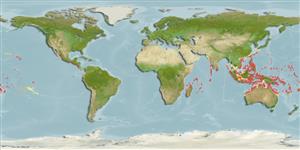Classification / Names
Common names from other countries
Main reference
Size / Weight / Age
Max length : 90.0 cm FL male/unsexed; (Ref. 1602)
Environment
Marine; reef-associated; depth range 8 - 30 m (Ref. 90102), usually 15 - 20 m (Ref. 48637)
Climate / Range
Tropical; 25°C - 28°C (Ref. 27115), preferred ?; 33°N - 25°S
Distribution
Short description
Dorsal
spines
(total): 4 - 5;
Dorsal
soft rays
(total): 28-30;
Anal
spines: 2;
Anal
soft rays: 27 - 28. Distinctive humped back; horn only in adult males. A few scattered small dark-edged pale spots on postorbital head and body above pectoral fins. No white margin posteriorly on caudal fin. Profile of snout from mouth to eye strongly sloping, forming an angle of about 40° to horizontal axis of body (Ref 9808).
IUCN Red List Status (Ref. 115185)
Threat to humans
Harmless
Human uses
Aquarium: commercial
More information
ReferencesAquacultureAquaculture profileStrainsGeneticsAllele frequenciesHeritabilityDiseasesProcessingMass conversion
Tools
Special reports
Download XML
Internet sources
Estimates of some properties based on models
Phylogenetic diversity index
PD50 = 0.5000 many relatives (e.g. carps) 0.5 - 2.0 few relatives (e.g. lungfishes)
Trophic Level
2.7 ±0.29 se; Based on food items.
Resilience
Low, minimum population doubling time 4.5 - 14 years (K=0.429; tmax=31)
Vulnerability
High to very high vulnerability (67 of 100)
Price category
